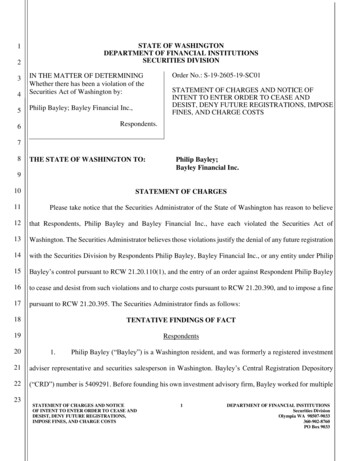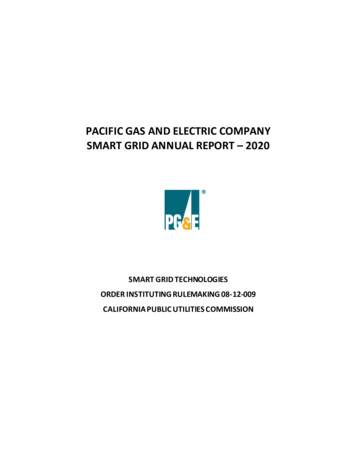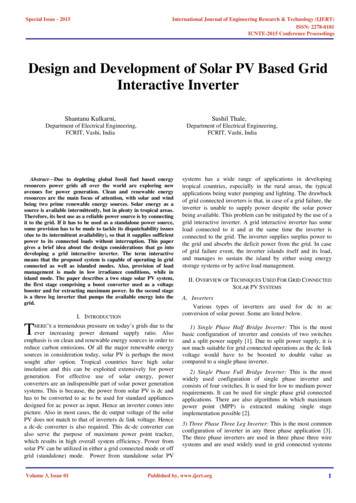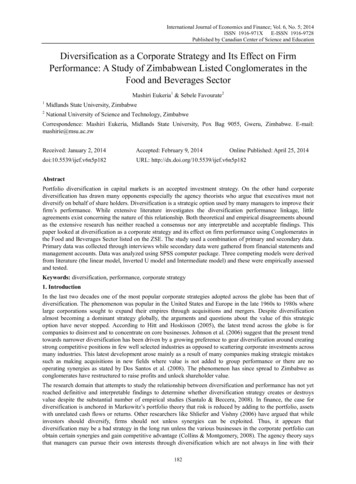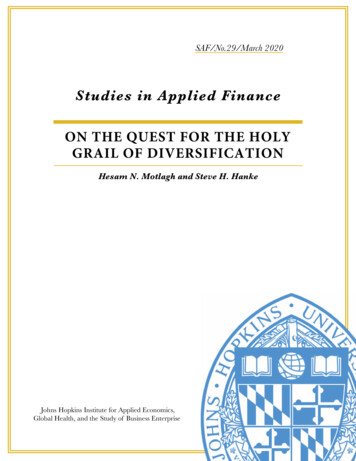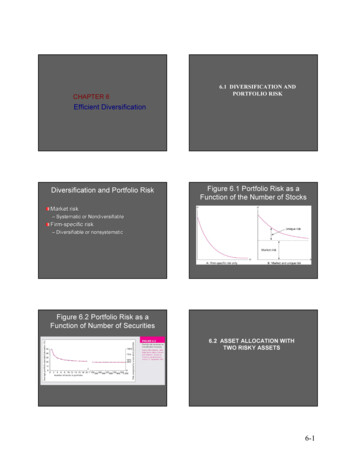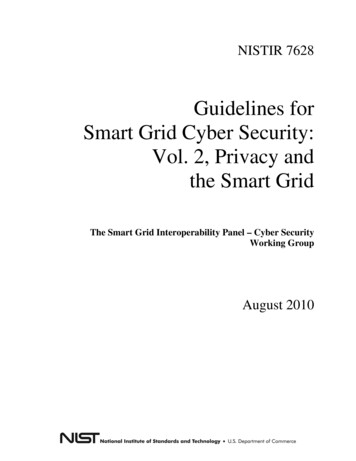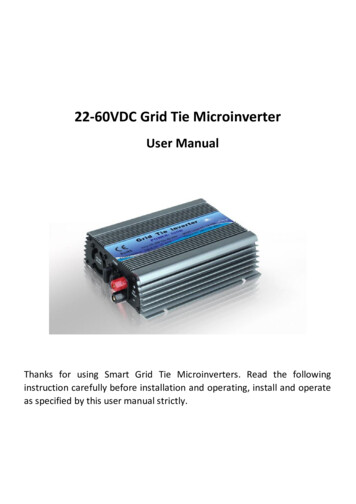
Transcription
Published by :http://www.ijert.orgInternational Journal of Engineering Research & Technology (IJERT)ISSN: 2278-0181Vol. 6 Issue 07, July - 2017Smart Grid Simulation Diversification ofDemand Side Power ManagementSuraj Kumar Khatkar1,Ms. Kousar Jahan2, Aayush Agrawal31, 2, 312, 3Electrical Engineering,National Institute of Technology,Nagaland,Abstract- Demand Side Management (DSM) is the processof managing the consumption of energy, generally to optimizeavailable and planned generation resources. DSM plays animportant role in improving energy efficiency, system reliabilityand security. DSM reduces costs for both customers and utilitiesand mitigates environmental damage. Smart grid has beenproposed as a way to increase grid robustness and reduceconsumption peaks and at the same time decrease electricitycosts for the end users. The aim is to develop simulation modelsfor smart grids focusing on smart houses. Smart industries whichare used to test if it is possible to reduce consumption peaks andat the same time increase grid stability. This paper proposes anddevelops a flexible simulation framework to study the behaviorsand impacts of smart grid enabled renewable energy source atdemand side, introduce the effects of demand side managementand analyzes the impact of renewable energy on demandresponse.Keywords- Smart grid, Renewable Energy (RE), DistributedGeneration (DG), Demand Response (DR), Demand SideManagement (DSM).I.INTRODUCTIONIN the modern smart grid, the diversity of loads andthe demands for highly efficient consumption, as well as theuse of renewable energy (solar, wind, biomass energy, etc.)generation and grid connection technology through the powerelectronics interfaces, have brought great challenges togoverning power quality. Compared with the traditional powersystem, the micro grid or distributed power plant, whichintegrates a variety of energy inputs, multiple loadcharacteristics, and varied energy conversion technologies, isa nonlinear and complex system with inter-coupling ofchemical energy, thermodynamics and electrodynamics.Meanwhile, due to the limitation of natural resources, thedistributed generations (DGs) appear the features ofintermittency, complexity, diversity and instability.Accordingly, some new problems with novel features occur inmaintaining power quality. Therefore, power quality controltheory and technology will play an important role in ensuringthe stable and secure operation of the power grid when microgrids or distributed power plants are connected to it. In theIndian national program for long and medium-term scientificand technological development (2010-2030), it is specificallymentioned that the analysis, detection, and control technologyfor power quality should be a priority objective in the energyfield, and it is highly recommended to promote to renewablesource and to control the power quality actively.Electric power systems constitute the fundamentalinfrastructure of modern society. Often continental in scale,IJERTV6IS070185Dr. K N Modi University,Newai Tonk Rajasthanelectric power grids and distribution networks reach virtuallyevery home, office, factory, and institution in developedcountries and have made remarkable. The connection ofdistributed resources, primarily small generators at themoment, is growing rapidly. The extent of interconnect, likethe number of sources, controls, and loads, has grown withtime. In terms of the sheer number of nodes, as well as thevariety of sources, controls, and loads, electric power grids areamong the most complex networks ever made.II.GENERAL FEATURES OF SMART GRIDThe term “smart grid” refers to the use of computer,communication, sensing, and control technology whichoperates in parallel with an electric power grid for the purposeof enhancing the reliability of electric power delivery,minimizing the cost of electric energy to consumers, andfacilitating the interconnection of new generating sourcesTo the grid, a smart grid may be defined in a number of ways.In simple words, smart grid is an electric grid that employsmonitoring, control, communication, and self-healingcapabilities to efficiently deliver reliable, economic, andsustainable electricity services. Smart grid has different aspectsand can be characterized as follows: “Self-healing” from power disturbance events.Enabling active participation by consumers in deresponse.Operating resiliently against physical and cyberattacks.Providing power quality for 21st century needs.Accommodating all generation and storage options.Enabling new products, services, and markets.Optimizing assets and operating efficiently.End-to-end electric power system (from fuel source, togeneration, transmission, distribution, and end use) of thefuture will: Allow secure and real-time 2-way power andinformation flowsEnable integration of intermittent renewable energysources and help decarbonizes power systemEnable effective demand management, customerchoice, secure and efficient operation of the gridEnable the secure collection and communication ofdetailed data regarding energy usage to help reducedemand and increase efficiency.www.ijert.org(This work is licensed under a Creative Commons Attribution 4.0 International License.)267
Published by :http://www.ijert.orgIII.International Journal of Engineering Research & Technology (IJERT)ISSN: 2278-0181Vol. 6 Issue 07, July - 2017DEMAND SIDE POWER MANAGEMENT Demand-side management will be evaluated against nodemand-side management alternatives. The conceptalso requires that selected demand-side managementprograms further these objectives to at least as great anextent as no demand-side management alternatives,such as generating units, purchased power or supplyside storage devices. In other words, it requires thatdemand-side management alternatives be compared tosupply-side alternatives. It is at this stage of evaluationthat demand-side management becomes part of theintegrated resource planning process.Demand-side management value is influenced by loadshape. Finally, this definition of demand- sidemanagement focuses upon the load shape. This impliesan evaluation process that examines the value ofprograms according to how they influence costs andbenefits throughout the day, week, month, and year.Smart Grid demand side power management describefollowing attributes Deployment and integration of demand response,demand side resources and energy efficiencyresources.Deployment and integration of distributed resourcesand generation, including renewable resources.Deployment of smart technologies for metering,communications concerning grid operations/statusand distribution automation.Adoption of Demand Side Management (DSM)techniques like volt/VAR control, voltage reduction,etc.Deployment and integration of advanced electricitystorage and peak-shaving technologies, includingplug-in electric and hybrid electric vehicles, etc.A. Demand ResponseDemand response (DR) refers to mechanisms tomanage the demand from customers in response to supplyconditions, for example, having electricity customers reducetheir consumption at critical times or in response to marketprices. There has been a recent upsurge in interest and activityin demand response, primarily due to the tight supplyconditions in certain regions of the country that have created aneed for resources that can be quickly deployed. Demandresponse can broadly be of two types, incentive-based demandresponse and time-based rates. Incentive based demandresponse includes direct load control, interruptible/curtailsable rates, demand bidding/buyback programs, emergencydemand response programs, capacity market programs, andancillary services market programs.B. Demand Side Power Management“Demand-side power management is the planning,implementation and monitoring of those utility activitiesdesigned to influence customer use of electricity in ways thatwill produce desired changes in the utility’s load shape, i.e.,changes in the time pattern and magnitude of a utility’s load.Utility programs falling under the umbrella of demand-sidemanagement include load management, new uses, strategicconservation, electrification, customer generation andadjustments in market share.” Demand-side management iseven more encompassing than the above definition impliesbecause it includes the management of all forms of energy atthe demand side, not just electricity. In addition, groups otherthan just electric utilities (including natural gas suppliers,government organizations, nonprofit groups, and privateparties) implement demand-side management programs. Ingeneral, demand-side management embraces the followingcritical aspects of energy planning: Demand-side management will influence customer use.Any program intended to influence the customer’s useof energy is considered demand-side management. Demand-side management must achieve selectedobjectives. To constitute a desired load shape change,the program must further the achievement of selectedobjectives.IJERTV6IS070185 C. Integration of Renewable Energy SourceIn case of smart grid, Renewable Energy has beenone of the rising trends in the field of Energy engineering.Renewable energy system has its source over the renewableresources such as solar, wind, tidal, wave, biomass etc. Powerextraction through tidal and wave energy is bounded due toless availability; lack of technological Improvements thesecomponents, incorporating the applicable criteria that Follow.Distributed RE sources may potentially delay upgrade oftransmission and distribution infrastructures with increasingdemand. Therefore, RE resources at the residential levelshould be utilized to get the most benefits out of residentialdemand response (DR) programs. Integration of Renewablesource at distribution to reduced power demand and improvesgrid stability and reliability and improves voltage profile,active power and reactive power and also improve voltageregulation and grid efficiency.IV.DISTRIBUTION END POWER MANAGEMENTDemand side centric flexible simulation frameworkproposed a simulation framework that is open to integration ofdifferent components under the smart grid infrastructure, andputs more emphasis on the residential demand side of thestory.Fig.1 Distribution End with Distributed Generation at load sideThis framework aims at providing an easy interface forimplementing different appliance coordination algorithms andperforming simulation tests with minimal effort.www.ijert.org(This work is licensed under a Creative Commons Attribution 4.0 International License.)268
Published by :http://www.ijert.orgInternational Journal of Engineering Research & Technology (IJERT)ISSN: 2278-0181Vol. 6 Issue 07, July - 2017Load data:Smart grid power system incorporating residentialhomes, residential industry with electric appliances from thedemand side and renewable energy generation mixrepresenting the distribution side. Solar power was added tothe distribution end, industry and homes.Fig.2 Distribution End with PV’s, DG Integration to GridDistributed Generation added on load side Solar Energy (photovoltaic & thermal)Wind EnergyBio-energy and FuelsFuel Cells and UPS Power(a) Solar House data(a) Industry(b) Smart Houses data(b) Residential HousesFig.2 Load Neighborhood ModelV.SIMULATION RESULTSSimulationPower flow simulations return voltage and currentphasor. These quantities are computed in the frequencydomain using complex numbers, and by specifying the fixedfrequency of interest (e.g., 50/60 Hz). Phasors, however, onlycontain information about their magnitude (root-mean square,RMS) and phase angle.Time StepThe simulation time step (or interval) defines howoften the simulation's solutions are computed. Since it wasdetermined that load flow simulations were appropriate forthis work, the time step was matched to the time step of therecorded data provided by given data (Δt 1 min 60 s).Run TimeLoad flow simulations execute faster than transientones for the same circuit topology. This stems from the totalnumber of solutions required to complete a simulation. Forexample, a 24 Hour load flow solution requires 24 3600/ 60 1,440 solutions. A 24 hour transient solution requires24 3600 50 10 6 1.728 109 solutions.Simulation Time SpanThe simulation time span defines the stop time of thesimulation. Since load flow simulations execute rapidly, thisstop time can be set to 24 hours or 7 days or Monthly orYearly. On the other hand, in the case of transient simulations,setting these stop values to anything more than secondsproduces undesirable simulation wait times.(c) Smart Industry data(d) Heavy industry dataFig3. Load dataRE was added to the distribution end, industry’s,homes and it changes demand Response and peak demand.Demand response in principle can enhance the overall systemoperation. Positive outcomes are especially associated withthe increased level of penetration of variablerenewable.Integration of Renewable source at distribution endto reduced power demand and improves grid stability andreliability with much reliable and secure the grid suddenchange in load. Demand Side Management (DSM) is theprocess of managing the consumption of energy, generally tooptimize available and planned generation resources. DSMplays an important role in improving energy efficiency,system reliability and security. DSM reduces costs for bothcustomers and utilities and mitigates environmental damage. Ithelp to improves voltage profile, active power and reactivepower and also improve voltage regulation and gridefficiency-Fig.4 Power availability on Smart Industry’s and Smart House’sIJERTV6IS070185www.ijert.org(This work is licensed under a Creative Commons Attribution 4.0 International License.)269
Published by :http://www.ijert.orgInternational Journal of Engineering Research & Technology (IJERT)ISSN: 2278-0181Vol. 6 Issue 07, July - 2017 DSM for improving Voltage and currentDuring operation the primary or intermediate energy sourceshave to be controlled to adjust voltage and current to matchthe operation of loads connected in the grid. In worst case, theload should be disconnected by the controller.Fig.5 Voltage, current and Power Measurement House1 and House2A. Demand Side Power management conditionsCase1When House power [Solar wind fuel cell UPS power] Then, Supply power to Grid Housepower - [Solar wind fuel cell UPS power],Grid act as load.Case2When House power [Solar wind fuel cell UPS power] Then, Grid supply power Housepower - [Solar wind fuel cell UPS power],Grid act as source.Case3When House power [Solar wind fuel cell UPS power] Then, Grid supply Power 0, Optimumpower management.Case4When [Solar wind fuel cell UPS Power] 0.Then, Grid supply Power House Power. Thiscondition is called Peak Demand.B. DSM Response To System as DSM for improving system reliabilityThe earliest and most commonly practiced DSM focuses onsystem reliability. A customer, often a large industrial facility,agrees to reduce load to guarantee system reliability underpeak demand conditions or other emergency system events,and is paid an incentive for doing so. Since they are designedfor emergency use, these DSM programs are infrequentlycalled upon. DSM for improving system efficiencyMore recently the focus of DSM has been increasingly placedon system efficiency. Many DSM programs have begun tofocus on non-crisis peak shaving – flattening load curves toimprove the efficiency of long-term power system capacityuse, since the generation, transmission and distributioncapacity of a power system is sized to meet the expected peakdemand. DSM for improving system flexibilityThis emerging application of DSM is very important forsupporting RE integration, as mentioned in System reliabilityObjective Frequency of calling Participants Direction Demandresponse, power management, System efficiency and SystemFlexibility.IJERTV6IS070185 DSM for improving Supply and Demand BalanceThis is more of an optimization function during gridconnection operation. However in the islanded mode,available storage should be used. In addition, the 8 controllershould incorporate demand response events during this phaseof operation to ensure reliability and security of the whole orpart of the system. DSM for improving Power QualityPower quality should be maintained for grid in islandedoperation with sufficient supply of reactive energy to shrinkvoltage sags. The energy storage devices should react rapidlyto frequency and voltage change by charging/discharging. Thecontrol strategies for balancing the dynamic demand in a gridconnected hybrid system have been proposed. The aim of thispaper is to enhance the greatest use of solar and wind powerby maintaining uninterrupted power to the customers. DSMcontrol strategies the power in the grid is made reliable withimproved quality. Modeling and simulations were done inMATLAB/Simulink. The simulations were presented toevaluate the dynamic performance of the hybrid system underproposed demand balancing methodology.VI.CONCLUSIONThere is significant potential to increase thefunctionality of typical demand-side management measures,typicaldemand response strategies, and typicalimplementation of building-level distributed energyresources by combining them in a cohesive, networkedpackage that fully utilizes smart energy-efficient enduesdevices, advanced whole-building control systems. It can beconcluded that with the advancements being made in thearea of renewable energy and distributed power generation,Smart grid has a emending and critical role in the future ofefficient power generation and distribution. Renewableenergy system is an innovative option for electricitygeneration, especially the PV system as it is a clean energyresource. However, to achieve a goal, a lots of issues needto be solved or addressed. These issues are basically relatedto the design and size of the system, the suitable andeffective model which can cover the technical and financialaspects of PV smart grid to supply electricity, and theequalized electricity price for integrating PV in a smart gridsystem. Analyzes the introduction effect of demand sidemanagement such as improvement rate of supply anddemand balance and increasing quantity of renewableenergy, Easy setting change of the grid and demand sidecondition by the adoption of module architecture andeffective simulation is possible.www.ijert.org(This work is licensed under a Creative Commons Attribution 4.0 International License.)270
Published by :http://www.ijert.orgInternational Journal of Engineering Research & Technology (IJERT)ISSN: 2278-0181Vol. 6 Issue 07, July - 2017REFERENCESR. Brown, “Impact of smart grid on distribution system design,” inProc. IEEE Power Energy Soc. Gen. Meeting, 2008.[2] International Energy Agency: World Energy Outlook 2011 OECD/IEA 2011.[3] J. R. Aguero, P. Chongfuangprinya, S. Shao, L. Xu, et al.,"Integration of plug-in electric vehicles and distributed energyresources on power distribution systems," in IEEE Electric VehicleConference, 2012.[4] A. Kwasinski, A. Toliyat, and F. M. Uriarte, "Effects of highpenetration levels of residential photovoltaic generation:Observations from field data," in International Conference onRenewable Energy Research and Applications (ICRERA), Nagasaki,Japan, Nov. 11-14, 2012.[5] L. Bird, M. Milligan, and D. Lew “Integrating Variable RenewableEnergy: Challenges and Solutions,” Technical Report NREL/TP6A20-60451 September 2013.[6] R. K Singh, S.K Choudhary, and Paul,R.Kumar, “study of IndianPower Sector for Planned Capacity, ÄKGEC International Journal ofTechnology, vol. 4,No.2,pp.34-38,2013[7] Anthony Papavasiliou, and Shmuel S. Oren, “Large scale Integrationof deferrable demand and renewable energy source,” IEEETRANSACTIONS ON POWER SYSTEMS, VOL. 29, NO. 1,JANUARY 2014[8] S.J.Ben Christopher, “Dynamic demand balancing using demand sidemanagement technique in a grid connected hybrid system,”International Journal of Renewable Energy Research, Vol. 4, No.4,2014.[9] Fabian M. Uriarte and Robert. E. Hebner, “Residential Smart Grids:Before and After the Appearance of PVs and EVs”, IEEEInternational Conference on Smart Grid Communications 2014.[10] Yogita Ashtekar, and Gopi Dhole, “Effect of demand sidemanagement on present Indian power sector scenario,” IJIRSETTransl. J. Magn. Japan, Vol. 4, Issue 2, February 2015[11] Sushmita Banerjee and Abhisek Meshram, “Integration of renewableenergy sources in smart grid,”IJIRSET Transl. Vol. 3, Issue 3, March2015.[12] Bethany Speer and Mackay Miller, “Roll of smart grid in IntegratingRenewable Energy,” Technical Report NREL/TP- 6A20-63919 May2015.AUTHOR PROFILE[1]IJERTV6IS070185Suraj Kumar Khatkar is presentlyworking as BSNL JE NE-I, India. Hedid M. Tech in Power SystemEngineering in NIT Nagaland. His areaof interests in the field of Smart GridIntegration, Demand Response andDemand Side Power managements,modeling controller for nonlinear realdynamic system, Renewable Energy source, Power systemload Economic dispatch and Unit Commitment, LFC, Loadflow Study and Fault Protection in Power systemMs. Kousar Jahan is presentlypursuing M. Tech in Power SystemEngineering in Dr. K N ModiUniversity, Newai, Tonk Rajasthan.Her area of interests in the field ofload forecasting, Demand ResponseandDemandSidePowermanagements, Renewable Energysource, Power system load Economic dispatch and UnitCommitment, LFC, Load flow Study and Fault Protection inPower system.Aayush Agrawal is presentlypursuing M. Tech in Power SystemEngineering in Dr. K N ModiUniversity,Newai,TonkRajasthan. His area of interests inthe field of Demand Response andDemandSidePowermanagements, Renewable Energysource, Power system load Economic dispatch and UnitCommitment, LFC, Load flow.www.ijert.org(This work is licensed under a Creative Commons Attribution 4.0 International License.)271
B. Demand Side Power Management "Demand-side power management is the planning, implementation and monitoring of those utility activities designed to influence customer use of electricity in ways that will produce desired changes in the utility's load shape, i.e., changes in the time pattern and magnitude of a utility's load.
